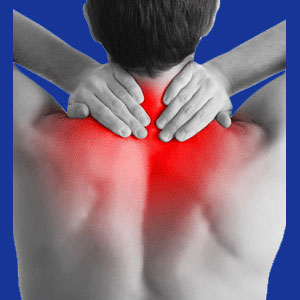
Neck and upper back pain is one of the most common of all combination symptom sets in the upper dorsal region. The cervicothoracic juncture can be the site of many painful expressions, caused by a great diversity of source processes. It is vital to understand that the anatomy of the neck and upper back are interrelated in many ways and depend greatly on each other to provide the physical functionality that we require to perform many movements with our heads, shoulders, arms and hands. The mid to lower cervical region and the uppermost thoracic region contain the nerves that innervate the muscles which provide movement to much of the upper anatomy. These areas are also well known to suffer rapid degeneration due to constant stress, as well as the propensity for injury due to a great number of factors.
This essay details cervicothoracic pain syndromes that typically strike the side of the neck, the base of the neck and the region in between the shoulders. We will provide information on the common causes of cervicothoracic pain and also provide some advice for patients who are affected by these often debilitating spinal or muscular problems.
Neck and Upper Back Pain Locations
The cervical spine joins into the thoracic spine at a location called the cervicothoracic juncture, also known as the cervicothoracic frontier. This anatomical location exists between the C7 and T1 vertebral bones and is marked by the cervicothoracic disc, also known as C7/T1. When a spinal abnormality exists in this region, it can affect the functionality and sensory signals for the entire regional area. Pain might be experienced unilaterally or bilaterally in the sides or back of the neck. Pain often radiates outwards from in between the shoulders or may favor one side or the other.
Some patients might demonstrate multiple spinal pathologies that can create symptoms virtually the entire length of the neck and well into the upper back. This is actually very common, since multiple disc pathologies, large areas of spinal stenosis and broad regions of osteoarthritis are all found in this area in a substantial segment of the general population.
When it comes to muscular pain syndromes, pain is virtually always focused unilaterally, although it may radiate to the other side of the body in lesser amounts. Discomfort is generally felt upon movement of the head, neck, shoulders or arms, as well as with particular muscular exertions of the general upper body.
Nonstructural pain conditions, such as those related to disease or mindbody factors, might be far less predictable in their locational influence. In fact, some of these syndromes are truly far ranging, often affecting the entire upper body in ways that would be impossible to experience from a single spinal or muscular pathology.
Neck and Upper Back Symptom Explanations
Categorization of this common variety of combination neck pain can be accomplished only through comprehensive diagnostic evaluation utilizing physical exam, spinal imaging, symptomatic correlation and other procedures. Failure to provide a thorough diagnostic process often results in an incomplete or incorrect diagnosis; subsequently causing poor treatment outcomes and general patient dissatisfaction with care. The following are the most common explanations of combination neck and upper back symptoms:
Central and foraminal stenosis can create areas of pain, tingling, numbness and eventual weakness in the lower neck and upper back. However, these are also some of the least accurate diagnoses rendered, since most cases of foraminal and central canal narrowing are completely innocuous and not symptom-generating. In cases of central stenosis, symptoms may vary greatly, but should focus more on neurological deficits than simple pain. In cases of neuroforaminal stenosis, the symptoms should also gravitate towards focal and correlating areas of paresthesia and weakness, since pain will only be a short-term expression, if it exists at all. Both conditions can be caused by herniated discs, osteoarthritic buildup, ligamentous issues, congenital disposition and many other factors, such as vertebral subluxation, irregular spinal curvature and traumatic injury.
Facet joint arthrosis might be responsible for some cases of minor localized pain in the lower neck and upper back. Most facet degeneration is normal, expected and asymptomatic.
Muscular, ligamentous and tendon-related nonspinal causations are extremely common explanations for pain in the cervicothoracic area. There are many layers of muscular structures here that are all inter-related in their functionality. Injury, imbalance or other causes can all create widespread pain that might be severe and focal or dull and diffuse. Muscular pain syndromes should not become chronic problems, unless they are posture-related, driven by repetitive strain or induced by an ischemic mindbody process.
Neck and Upper Back Pain Guidance
The vast majority of patients who write with questions about neck and upper back symptomology have suffered some minor soft tissue strain. Most complain of pain when turning the head or using the arms and most will recover in a few days to a few weeks time, without any special treatment needed.
Some patients demonstrate obvious soft tissue related syndromes, but endure lasting symptoms that usually point to some disease-related, systemic or psychogenic causation being responsible for the misery. Most structural explanations for chronic muscular pain are baseless and incorrect, which goes a long way in elucidating why treatments for these conditions are usually grossly ineffective.
Spinal issues may resolve by themselves, especially if they are of a temporary nature, or may require medical intervention to eliminate the underlying structural problem sourcing the pain. Some patients may even require surgery to resolve serious spinal issues, but this is not a common treatment fate. On the contrary, the vast majority of spinally-blamed pain syndromes are not actually caused by the innocent and incidental vertebral and intervertebral abnormalities often implicated as the source. Therefore, most spinal-targeting treatment modalities are not actually needed or even indicated, but are used due to mistaken diagnosis.
Disease and systemic pain will require specialize diagnostic evaluation, but will usually become apparent during any overall health exam and blood testing.
The least diagnosed, and ironically, most common cause of chronic, unresponsive neck and upper back pain, is certainly the subconscious mind. Dorsal pain is a well recognized tension equivalent that is used to camouflage emotional issues through the use of effective pain generating mechanisms. The existence of psychogenic neck pain has been clinically proven and usually responds well to mindbody interventions, such as knowledge therapy.
Neck Pain > Combination Neck Pain > Neck and Upper Back Pain





